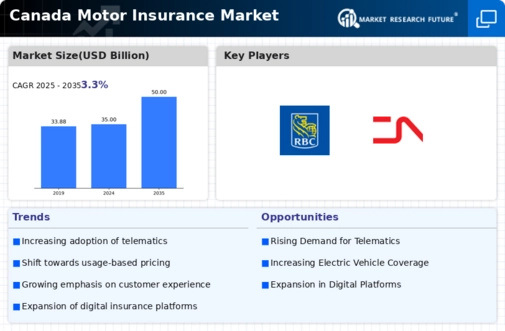Rising Vehicle Ownership Rates
The motor insurance market in Canada is experiencing growth driven by rising vehicle ownership rates. As more Canadians acquire vehicles, the demand for motor insurance coverage increases correspondingly. Statistics indicate that vehicle registrations in Canada have risen by approximately 3% annually over the past five years. This trend suggests a robust market for insurers, as each new vehicle requires insurance coverage. Additionally, the demographic shift towards urbanization may further contribute to this growth, as urban residents often rely on personal vehicles for commuting. Consequently, the expansion of the vehicle fleet is likely to create opportunities for insurers to develop tailored products that meet the diverse needs of new vehicle owners.
Economic Factors and Disposable Income
Economic conditions play a crucial role in shaping the motor insurance market in Canada. As the economy strengthens, disposable income levels tend to rise, allowing consumers to allocate more funds towards insurance premiums. Recent data suggests that the average household income in Canada has increased by 5% over the last year, which may lead to higher spending on comprehensive insurance coverage. Additionally, fluctuations in fuel prices and vehicle maintenance costs can influence consumer behavior regarding insurance purchases. Insurers may need to adapt their offerings to align with changing economic conditions, ensuring that their products remain accessible and appealing to a broader audience in the motor insurance market.
Increased Focus on Customer Experience
The motor insurance market in Canada is witnessing a shift towards enhanced customer experience, which is a key driver of growth. Insurers are increasingly investing in digital platforms and user-friendly interfaces to streamline the purchasing process and improve customer engagement. This trend is evidenced by the rise of online policy management tools and mobile applications that allow customers to manage their insurance needs conveniently. Furthermore, customer satisfaction surveys indicate that 75% of policyholders prioritize ease of access and responsiveness from their insurers. As competition intensifies, companies that prioritize customer experience may gain a competitive edge, potentially leading to increased market share in the motor insurance market.
Emergence of Alternative Mobility Solutions
The motor insurance market in Canada is being shaped by the emergence of alternative mobility solutions. These include ride-sharing and car-sharing services. These platforms are changing the way Canadians view vehicle ownership and insurance needs. As more individuals opt for shared mobility options, traditional insurance models may need to evolve. For instance, insurers may explore usage-based insurance products tailored for users of ride-sharing services. This shift could lead to a decrease in personal vehicle ownership, thereby impacting the overall demand for conventional motor insurance. The growth of these alternative solutions suggests a potential transformation in the motor insurance market, prompting insurers to innovate and adapt their strategies to meet the changing landscape.
Technological Advancements in Vehicle Safety
Advancements in vehicle safety technology are increasingly influencing the motor insurance market in Canada. Innovations such as automatic braking systems, lane departure warnings, and collision avoidance systems are becoming standard in new vehicles. These technologies not only enhance driver safety but also reduce the frequency and severity of accidents. As a result, insurers may adjust their premium calculations based on the enhanced safety features of vehicles. The integration of these technologies could lead to a potential decrease in claims, thereby positively impacting the profitability of the motor insurance market. Furthermore, the adoption of advanced driver assistance systems (ADAS) is projected to grow, with estimates suggesting that by 2026, over 50% of new vehicles sold in Canada will be equipped with such technologies.













Leave a Comment